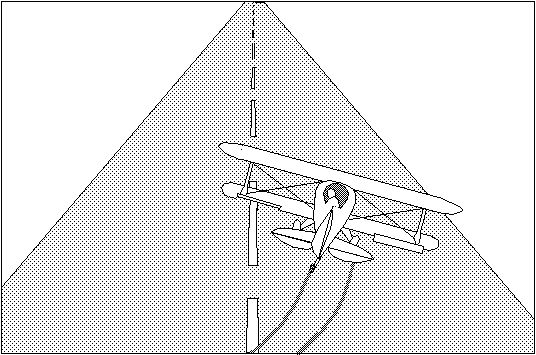

When the great day came my friends were waiting by the edge of the runway with a fire extinguisher as I pushed the throttle to the stop and the little machine accelerated rapidly with a roar. As expected, the rudder was exquisitely sensitive and little stabs with my feet made her lurch left and right but before I had time to get into trouble that big engine had torn us from the earth and the Pitts became the sweetest flying machine I had ever flown! And after half an hour of sheer bliss doing loops and rolls and Hammerheads I turned her nose back to the airport and prepared for landing. The major handicap during the approach was visibility - or lack of it. I had to corkscrew left and right to check for traffic and watch the runway. It was like flying a J-3 from the back seat with a big guy up front blocking the view - except the visibility was worse! With the power back, on final approach, she dropped like a sewer cover and I held the rudder hard over to keep an eye on the numbers rushing up at me. I had spent some time before takeoff studying the perspective of the small section of runway visible from the cockpit, and I now flared out and gently worked the throttle to recreate that same perspective. To my complete amazement the touchdown was a perfect three-pointer and as I chopped the power and rolled along with the stick back I thought, "that wasn't so hard at all!"
What took place next takes much longer to tell than it did to happen. The airplane lost all flying speed rolling straight as an arrow and was firmly on the ground when her nose swung left just a little. No problem, I was ready with a little right rudder but no sooner had I applied it than she swung right a bit. Not getting too excited I applied a little left rudder and she swung firmly to the left. Before I knew what had hit me we were swerving madly left and right first up on one wheel then the other, all at a speed too low to warrant a go-around. The last crazy swerve to the left had us up on the right wheel so far that the right wing scraped the runway and pivoted us around to the right, coming finally to rest facing the traffic on final.
A few evenings of dope and fabric work repaired the damage, and it took many more landings to master the plane. It was not until I had been flying the Pitts for a few months, however, that I finally figured out what had happened to me that first time and what I was doing instinctively to make successful landings now. What it amounted to was I had encountered a new force that in all my flying experience I had never noticed nor read about. And I suspect that other Pitts pilots who advise against lingering in that transition speed are not fully aware themselves of the nature of that force or what it is they are doing instinctively to control the plane in those brief seconds on takeoff and landing. It is rather like riding a motorcycle and not knowing what makes it turn. Most motorcyclists know that you don't turn with the handlebars but rather you lean into the turn. Few of them are aware, however, that the way you lean to the right for instance is by turning the handlebar momentarily to the left, then neutralizing it when the bank is established. The handlebar is your roll control, a right turn rolls left and vice versa. (If you find this hard to believe, try it next time. Just waggle the handlebar while driving straight and watch the bike "wag the wings.") I call this phenomenon "motorcycle effect" though many expert motorcyclists who ride by feel are blissfully unaware of what they are actually doing with the controls. Well the mysterious force that I had encountered in those fleeting moments on the runway was none other than this motorcycle effect.
Picture the following situation. You are on the runway after touchdown and you have lost enough speed so that your ailerons can no longer provide roll control, but you are otherwise still moving fairly fast. You are heading, let us say, somewhat towards the right side of the runway, but have already started correcting back to the left with the left rudder.

Having grasped the principle of motorcycle effect I would advocate that new pilots of narrow track gear taildraggers should taxi rapidly down the runway at motorcycle effect speeds - which in my Pitts is well below flying speed - and should practice holding the wings level by using the rudder as a roll control.